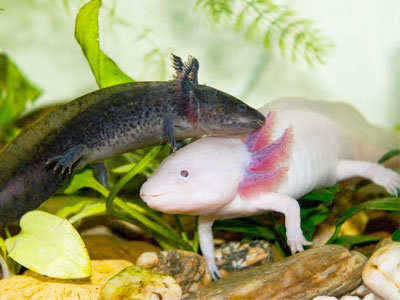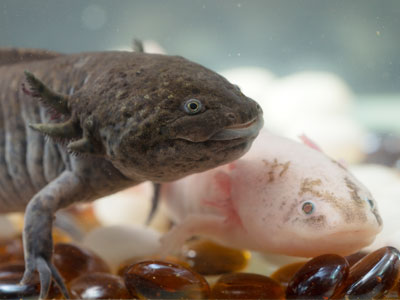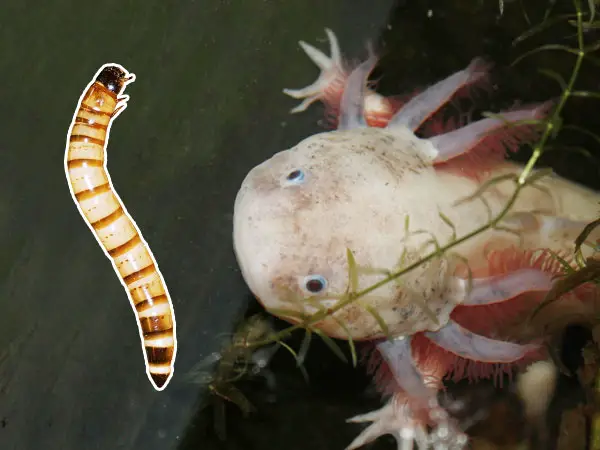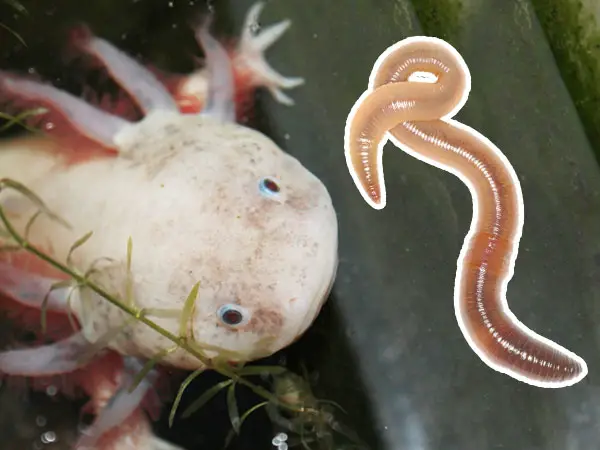
If you’ve gotten great at raising and taking care of axolotls, maybe it’s time for you to take things a step further and try your hand at breeding axolotls.
Axolotls breed in captivity too, so you don’t need to worry about that, but there are a few aspects of breeding axolotls that require your special attention.
In this comprehensive axolotl breeding guide, I will discuss the mating behavior of axolotls, how to tell the gender of axolotls, how to identify a pregnant axolotl, and other aspects of how axolotls breed.
Axolotls Reproduction
Axolotls can successfully reproduce, and they can be successfully raised in captivity. Some axolotls reach sexual maturity as soon as they hit 5 months, others much later.
Ideally, axolotls shouldn’t be allowed to mate until they’re 18 months of age. At least in the case of female axolotls it’s best to wait until she’s fully developed to avoid putting too much strain on their bodies before they’ve reached their full size.
Even after spawning, female axolotls should be allowed to recuperate for a few months before they’re allowed to breed again.
Male axolotls, on the other hand, can be allowed to breed sooner than females since they usually reach sexual maturity a bit earlier, usually by a few months.
Axolotls can be bred at any time of year, although December to June is their natural breeding season, and most axolotl enthusiasts report breeding success in the first part of the year.
There’s also an element of unpredictability to when axolotls breed, which may stem from the different ways male and female axolotls are stimulated by environmental factors.
For example, lowered temperatures (a sudden lowering in temperature) can trigger mating behavior in the male axolotl, but it’s not as efficient in triggering mating behavior in the female axolotl.
The best way to ensure that your axolotls breed successfully is to imitate their natural habitat as closely as possible including aspects related to seasonal changes like changes in natural light conditions and seasonal temperature changes.
For example, keeping your axolotls in a room that receives natural light may be beneficial in signaling to your axolotls the seasonal changes in daylight length and temperature.
It’s also a good idea to keep their breeding tank in a room where they won’t be disturbed and to create ideal tank conditions when it comes to temperature and water pH.
It’s also a good idea to have plants and aquarium decorations in the tank where the female can more easily lay her eggs.
Axolotls Mating Behavior
Axolotls have an interesting mating behavior that can only be described as a courtship dance of sorts that aims to lead the female onto the sperm packets deposited by the male, which are required to fertilize the female’s eggs.
The first sign that a male axolotl is interested in the female axolotl is that we can see the male swimming around, raising its tail and making vigorous twisting motions.
The male then also nudges the female’s hindquarters with its nose to see if the female is interested. She may also nudge the male’s hindquarters; hence the courtship dance I mentioned.
If the female axolotl shows a willingness to breed, the male axolotl positions himself in front of the female, nose to tail.
The male axolotl releases spermatophores (packets of sperm) and leads the female directly above these so that she can take them up her cloaca.
The male deposits around 5 to 25 of these spermatophores in the tank. These don’t stick to surfaces, but they’re required to be rather stationary so the female can take them up into her cloaca.
The entire process may take around an hour and the female can take up several such packets, which essentially result in the fertilization of her eggs.
But before you can even observe this type of behavior in your axolotl pair, you must make sure that you have a female-male pair.
While they’re still young, it’s difficult to tell the genders apart. The gender of axolotls can be determined most accurately when they reach sexual maturity.
Difference Between Male and Female Axolotls
There are many tips and tricks offered up on the internet to determine the gender of axolotls, but only a few of them are helpful in accurately sexing your axolotls.
Here are a few differences between female and male axolotls that can help you tell them apart:
- The body of the male axolotl is more elongated, and their tails are usually longer compared to that of the female axolotl
- Female axolotls have a more rounded body when viewed from above, especially when they reach sexual maturity because of the eggs they’re carrying inside
- The most reliable way to tell an axolotl’s gender is by looking at their cloaca — the male axolotl’s cloaca will be swollen, while the female’s will only display a tiny bump, if one at all.
Other methods or physical characteristics to tell genders apart aren’t reliable and they may very well lead to mistakes in identifying the gender of your axolotl.
If female and male axolotls are kept in the same aquarium, breeding will occur at some point or another, but there tends to be an element of unpredictability associated with this.
Breeders will often attempt to induce mating behavior in axolotls through various methods like manipulating lighting conditions and water temperature.
How often do Axolotls Breed?
If your axolotls are kept in good tank conditions (i.e. good diet coupled with ideal water parameters), they should breed at least once a year.
Many aquarists keep males and females separately for a few weeks before breeding and use the thermal shock method, which involves placing them from water that has a temperature of 20-22 °C (68-71 °F) into water that has a temperature of around 12-14 °C (54-57 °F) to induce courtship behavior and breeding.
However, many aquarists report that this method only triggers courtship behavior in male axolotls, therefore, I’m not convinced this method is the best way to go about breeding your axolotls.
Female axolotls can breed several times per year, so it’s likely that their breeding behaviors will line up naturally, without having to induce thermal shock, which can potentially stress them out.
Having them in a room with access to natural lighting conditions and without any artificial aquarium lighting and exposing them to seasonal temperature changes (within their acceptable range) can be beneficial in stimulating their natural breeding patterns.
How to Identify a Pregnant Axolotl?
You can’t really tell if a female axolotl is pregnant or not. Her belly will be rounder and plumper than that of the male’s, but that’s because of the eggs she’s carrying, which may or may not be fertilized yet.
Luckily, you don’t have to wait long to find out if your female axie is pregnant. The gestation period is quite short in axolotls. After a successful breeding and fertilization, spawning occurs within a few hours to a few days.
If you’ve allowed your axolotls to breed, you should be prepared for the outcome and get all your supplies ready for rearing baby axolotls.
Once spawning happens, it doesn’t take very long for baby axolotls to emerge from their eggs.
Do Axolotls Lay Eggs?
Yes, axolotls lay eggs. After the eggs of the female axolotl have been successfully fertilized, spawning will occur in a matter of hours to a few days.
The female can lay anywhere between 100 to 1500 eggs in one spawning. She will lay them everywhere in the aquarium — on leaves, rocks, pipes, and any other decoration you may have.
Depending on the type of axolotl you have, the eggs will be white in case of an albino axolotl (because of the lack of pigment) or dark brown if she’s another color morph.
After spawning, you should remove the adult axolotls to prevent them from eating the eggs.
The female axolotl’s body will start replacing eggs as soon as the first batch is laid. Now, if the female is not properly developed (hasn’t reached adulthood), this whole process will put strain on her body, and she may fall ill.
It’s recommended to separate the female and the male as soon as spawning is finished and give the female time to recuperate before the next fertilization.
You should keep them separated for at least a month, but 2-3 months is best for a full recovery.
How Long Does it Take for Axolotls Eggs to Hatch?
Depending on temperature and tank conditions, eggs can take anywhere from 2 to 3 weeks to hatch.
Aeration is important for eggs to develop normally, and it has been observed that eggs that were laid on plant leaves develop most optimally because of the increased water circulation, which has a beneficial effect on gaseous exchange.
Eggs will hatch faster if they’re kept in water with a higher temperature, just make sure the temperature is still in the safe range for axolotls. I usually aim for 20 °C (68 °F) and this temperature results in a 17-day hatching period.
If the eggs have been fertilized, the majority of the eggs will hatch. To aid the process, make sure there is enough aeration going on in the aquarium.
Having an air pump and air stone in your aquarium will certainly help with this but do make sure the water current isn’t strong.
How to Tell if Axolotls Eggs are Fertilized?
Luckily, it’s very easy to tell if axolotl eggs are fertilized or not because the female axolotl will not lay unfertilized eggs. That is, female axolotls only lay eggs if they’ve been fertilized.
That said, females can sometimes leak unfertilized eggs, but never in the high numbers they do when spawning. Unfertilized eggs can be removed, or you can leave them in the tank for your axies to eat them.
Because axolotls don’t lay unfertilized eggs, you can tell with a high degree of certainty that every time your axolotl lays eggs, those eggs will indeed be viable ones that could hatch if tank conditions remain ideal.
How Many Babies Can Axolotls Have?
Judging by the high number of eggs that axolotls can lay (between 100-1500), it’s safe to assume that axolotls can have a lot of babies.
Not all the eggs that have been laid will develop normally and hatch, but under the right conditions the majority will. However, the actual number is unpredictable.
In any event, it’s important to keep adults separated from the eggs and from juveniles to prevent them from eating eggs or babies.
And if you’re breeding axolotls, you should be prepared for a lot of eggs to hatch. You’ll also need to be prepared to feed and raise baby axolotls.
Baby axolotls don’t take on food immediately after hatching because they still rely on the yolk sac for sustenance. Within 72 hours or so, they’re ready to be fed.
Baby axolotls should only be fed live foods such as baby brine shrimp, daphnia, and microworms. Live foods are not only nutritious for them, but they’re the only food they’ll be interested in because they rely on their sight to detect food. You should feed baby axolotls once or twice a day.
Because baby axolotl foods are known to rapidly foul the water, you should remove uneaten food right away and perform regular water changes to avoid disturbing the water chemistry in the tank.
Can You Crossbreed Different Types of Axolotls?
Different types of axolotls can be crossbred with sometimes unpredictable and special results. There are various different axolotl color morphs, determined by their pigment cells that range from black brown to yellow and reddish pigments.
Here’s a quick overview of the major axolotl color morphs:
Wild Type
These types of axolotls are usually a shade of dark brown speckled with yellow speckles or patches.
Even within this category there some color variations in the sense that some specimens may be a darker or lighter shade of black or brown.
Leucistic (White)
White pinkish in color with small speckles on head and back, this is probably the most commonly seen axolotl type in home aquaria.
They are often mischaracterized as albino; however, they have black eyes and as such cannot be characterized as albino.
Melanoid
The melanoid is a variation on the wild type axolotl and can be distinguished by the fact that it lacks the shiny yellow pigment that’s typical of the wild type. It also has increased dark pigments, which results in a black axolotl.
Albino
The albiono axolotl is lacking melanophores (dark pigment cells). Within the albino category we can distinguish a few variations:
– the yellow/gold axolotl, which has normal migration of pigment cells but lacks melanophores
– the axanthic albino, which is almost entirely white and even lacks shiny pigment cells (iridophores)
– the white albino, which only has iridophores
– the melanoid albino, which only has tiny hints of yellow on head and back.
If you want to know more about the different types of axolotls, I encourage you to read up on axolotls genetics to see how the distribution of different pigment cells determine different axolotl morphs.
How to Stop Your Axolotls from Breeding?
If you have both a female and a male axolotl in the same tank, chances are they’ll breed at some point or another. And they do tend to do so at unexpected times.
If you’re not prepared to handle the possible influx of a high number of axolotl babies, the surest way to avoid breeding is to separate your axolotls.
Ideally, you should keep them in different tanks, but a separator mesh in the aquarium can also work if you don’t have an extra tank just yet.
If your axolotls mated and eggs are produced, you could manually remove as many eggs as you can, which can be a daunting task considering the number of eggs the female can release in single spawning.
Still, remove as many eggs you possibly can, and leave the rest in with the adults. Adult axolotls will eat the eggs or the larval axolotls upon hatching.
You can also offer up eggs or baby axolotls to breeders, many of whom will be glad to take them off your hands.
Conclusion
Breeding axolotls is not difficult per se, but there are a few elements of unpredictability that you should consider like the time your axolotls will breed and the number of eggs that a spawning event will produce.
After a spawning event, axolotls should be removed from the tank. You should ensure good aeration of the eggs without there being to strong of a current in the aquarium.
Eggs will hatch sooner at higher water temperature, but do be careful to still be within the range that is tolerated by axolotls.
If you’ve done everything right, you can expect to have baby axolotls to take care of in 2-3 weeks after the eggs were released.
Caring for baby axolotls has its own challenges, but it’s nothing you can’t handle if you’re well informed and prepared for the tasks that lie ahead.




